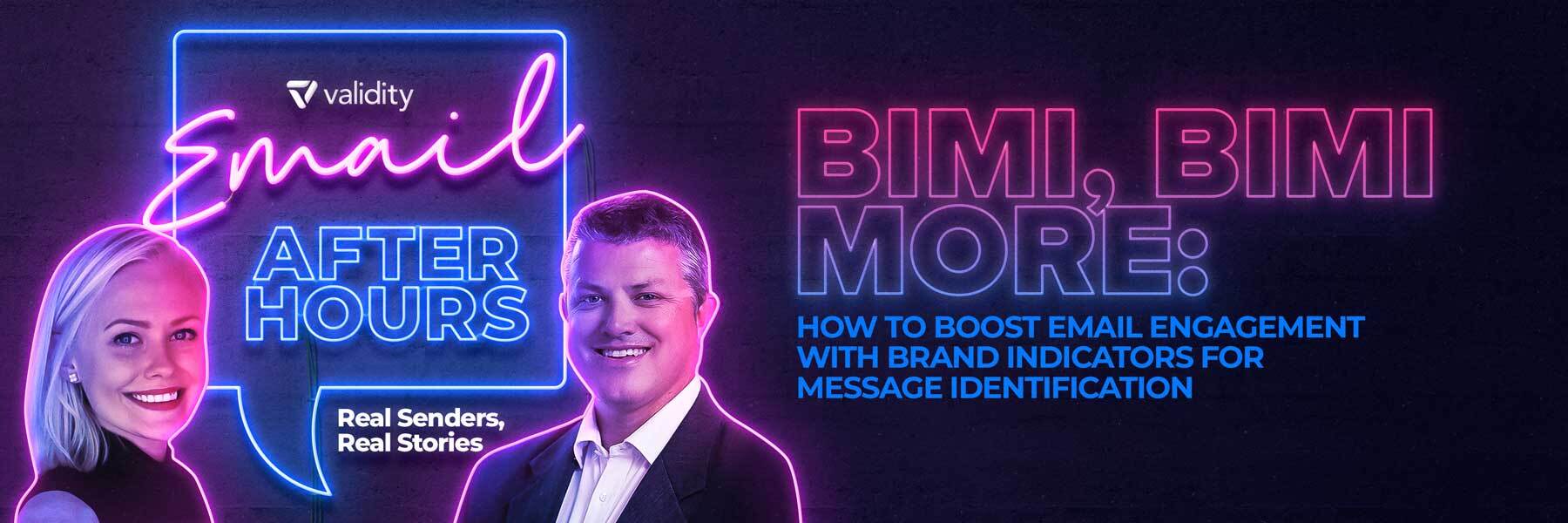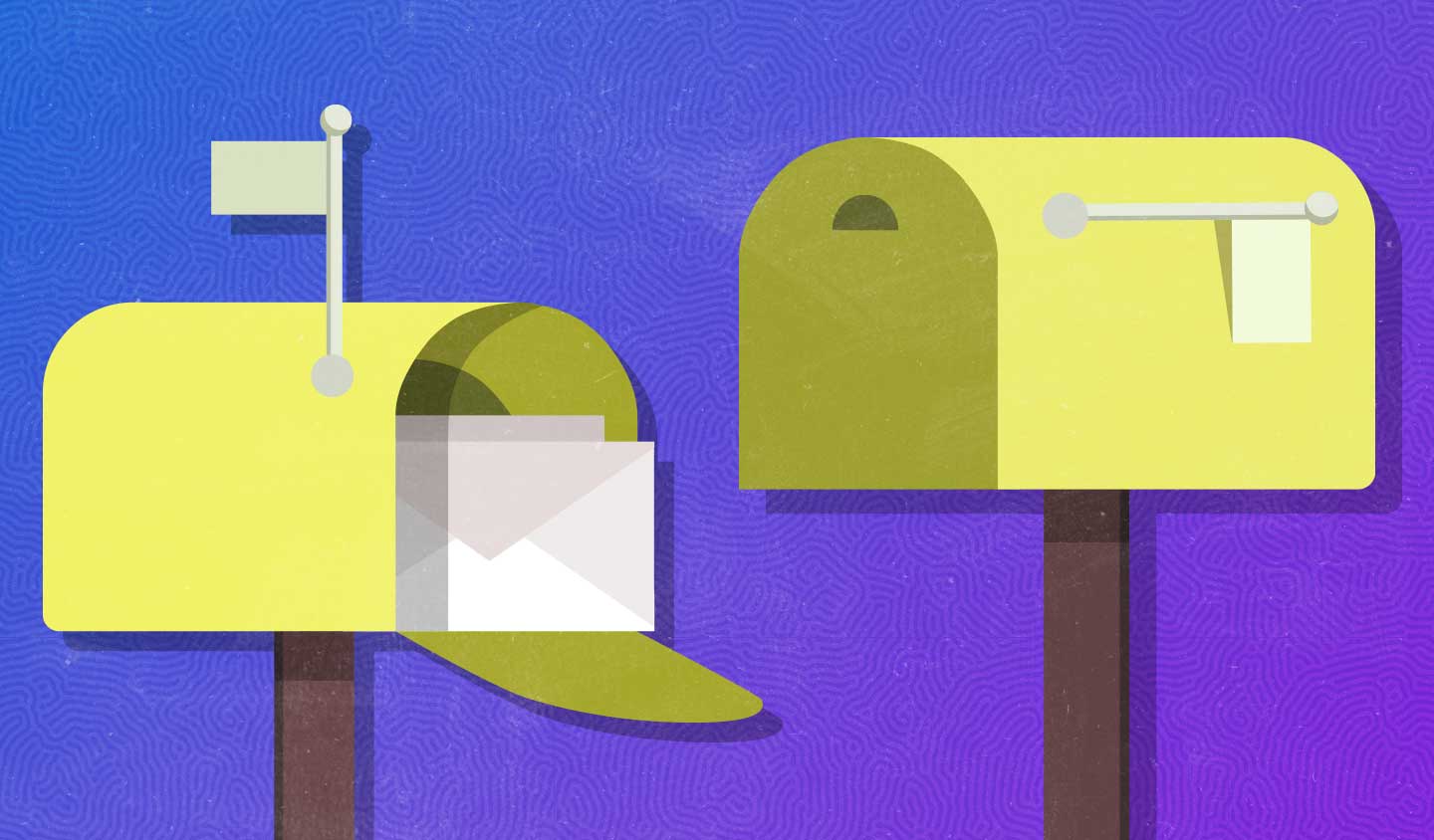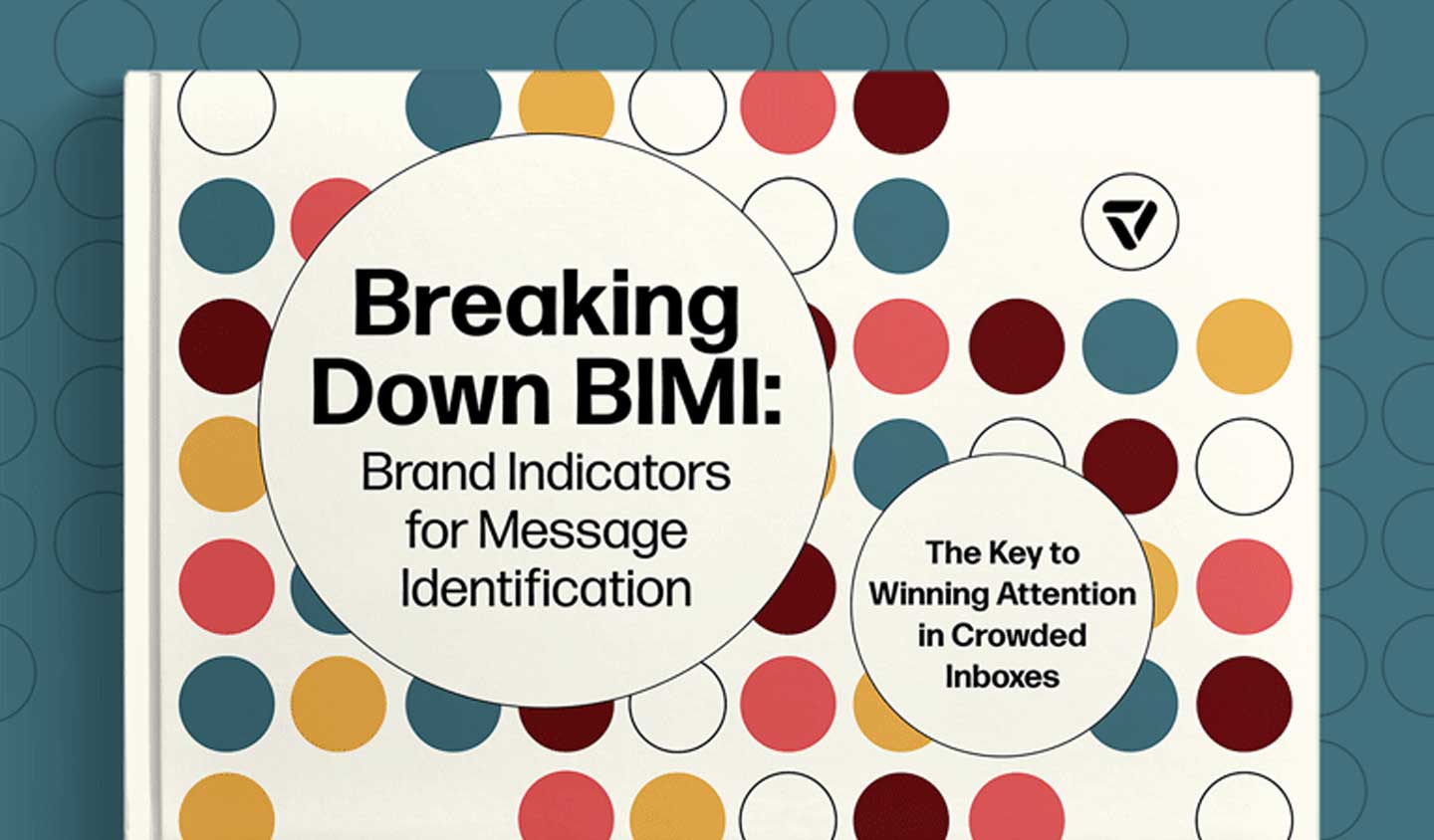Danielle Gallant – 00:00:03: Welcome to Email After Hours by Sender Score, powered by Validity. In our day jobs, we work with senders all over the world and help them tackle their toughest email challenges.
Guy Hanson – 00:00:14: But once we’re off the clock, we get together to share our experiences and discuss what’s keeping us and most other senders up at night. It’s all part of our mission to answer the single most important question for email senders. How can we give subscribers what they really want? We’re your host. My name is Guy Hanson.
Danielle Gallant – 00:00:37: And I’m Danielle Gallant. And this is Email After Hours.
Guy Hanson – 00:00:45: We’re here today to talk about Brand Indicators for Message Identification. BIMI for short. Now, you might be sitting there rolling your eyes and thinking, oh man, more acronym soup. But that’s exactly why we’re here today. And the conversation we’re going to have is going to dig into BIMI. How do you implement it? What kind of engagement uplifts are early adopters seeing? And why? Will having BIMI for your email marketing program make you look like a star sender? But before we do that, we need to talk to today’s guest.
Danielle Gallant – 00:01:20: Yes, and speaking of stars, I think we have someone who we can call Email Famous on the podcast today here for us. Not to intimidate you, but we’ve got Tom Bartel on the podcast today. So Tom, I’ll hand it over to you. Can you do a quick introduction, tell us what’s your day job, who are you, anything you think would be interesting.
Tom Bartel – 00:01:42: Yeah, thanks. Well, I appreciate that, Danielle. Bit much? I’ll try to fulfill that if I can today. Yes. So I head up Data Strategy and Global Data Partnerships here at Validity. So effectively, that makes me and my team responsible for making sure that we have the necessary and best data here to power the email success platforms and help our customers be successful.
Guy Hanson – 00:02:04: Now, Tom, I think you’re almost underplaying yourself a little bit because you work with the great and the good in the world of email. Global mailbox providers, filtering companies, big anti-spam vendors, you name it, you’ve got relationships with them. And it gives you a very unique perspective on our world. And it’s a world that’s full of threats. What keeps you up at night, and not just you, but the community as well?
Tom Bartel – 00:02:28: Yeah, I know you’ve nailed it, Guy. It’s weird to think about it from Validity Solutions perspective on the sending side, but what keeps me up, honestly, is malicious mail and the miscreants, because that’s really what drives everything. It all starts there. And I would say it’s as bad as it’s ever been. And I think people get this. It’s an arms race. When you’re a mailbox provider and a filtering company, it’s a cat and mouse back and forth in terms of securing systems. I’ve always said this. If you look back this is super anecdotal. If you look back over the last 10 to 15 years and just look at the top line statistics around, you know, 90 and percent is what I would say of all mail is spam. And that’s a statistic that the end might change slightly, but it’s 90 something and it’s been that way into its second decade now. Well, what does that mean? That means as a mailbox provider, if you can’t reject nine out of every ten connections to your system, you can’t operate in more direct terms than think at global scale, for every billion messages that a mailbox provider determines to be acceptable just for processing, for potential delivery, they probably had to reject 10 billion. You know, so the workload and the amount of work that these systems and these teams are doing to lay the foundation for a clean inbox experience is daunting and it’s really hidden from users from a sender’s perspective, then, yeah, that’s what keeps me up is what don’t I know? And this is why I love working in data, right? We need data to solve problems. Data creates visibility. And so it’s always a matter of how do I learn more and how do I understand what the problem is so I can solve it.
Danielle Gallant – 00:04:08: That’s a big one that keeps you up at night.
Tom Bartel – 00:04:11: Absolutely.
Danielle Gallant – 00:04:12: That’s no small topic. And speaking of topics, let’s get into the one that we’re going to really dive into today, and that is BIMI. So what can you tell us about BIMI in layman’s terms? Because as someone who has worked with Senders to actually implement this, it can be a bit of a beast. So let’s dispel it. Let’s get it out from just being another email acronym and part of that alphabet soup we have in this industry.
Tom Bartel – 00:04:35: Yeah, well, I think I already nailed it. BIMI is a lot more fun to pronounce as an acronym than it is as full phrase Brand Indicators for Message Identification. And we’ve been fortunate enough to be a part of that working group since its inception. Although I will say I don’t know we had anything to do with the naming on that. But it’s, I guess in layman’s terms, it’s an open protocol whereby mailbox providers could accurately present the brand logos that should be properly associated with delivered email messages for their users.
Danielle Gallant – 00:05:06: So it’s a face, we get our face, our logo out there in mailboxes, right. With BIMI, that’s what a sender would think of it as.
Tom Bartel – 00:05:14: I mean, effectively, right? I mean you think about we’re all familiar with a mail user application and the general constructs of how our inboxes are presented and how a message view might look. And there’s really what our friends at Yahoo, most mailbox providers might describe as an avatar space, right? And that could be your face or my face or guy’s face for personal mail, but from a commercial standpoint, for digital marketers, that becomes recognizable, identifiable space for that brand’s logo.
Guy Hanson- 00:05:42: Now, you don’t want my face next to them. You’re trying to encourage people to open the emails. But, Tom, you mentioned Yahoo. And I think BIMI has been around for a couple of years now. It probably feels like it took a little while to start getting traction. Yahoo was one of the early mailbox providers to support it. Gmail came along last year and now Apple Mail has joined the party this year. So where does that put us now? How many mailbox providers have we got who are currently supporting BIMI?
Tom Bartel – 00:06:09: Yeah, that’s great. As I said, it’s been a several year effort to this point. And in terms of implementations, there’s more than several, which sounds small, but these are global providers and also kind of regional representatives. On the global side, I would say you’re looking at large providers as you mentioned Yahoo. But also Google has been a long standing participant in BIMI and Apple has just recently joined the fray and has an initial implementation. So right there you have a critical mass and a huge chunk of any digital marketers recipient list right there. And we’re also starting to get other providers involved. So message security providers, so Proofpoints, Cloudmark for example, which is a partner to many mailbox providers. So that’s going to be another way that BIMI capability gets extended across the landscape. And then I did mention we do have some regional players. So La Poste in France for example, just joined Fastmail in Australia has been a long time working group member and there’s a lot more considering BIMI. So they’re in that process of implementing. So I would expect as you watch the BIMI group site to see more announcements about more implementations coming.
Guy Hanson – 00:07:15: So picking up on the ones that are considering it, do you think we’ll get to a stage at some point where all of the major players are supporting it?
Tom Bartel – 00:07:22: Yeah, I think so. I think there should be momentum building. The proving out the concept and developing an open standard is really challenging. These are complex systems, they all solve generally the same problem, but they’re implemented in extreme proprietary ways. Right? So how it gets implemented at a particular provider is going to be really distinctive, but to the degree that it rises to the level of priority such that it can become a project and get implemented, that’s all highly variable, right? Yeah, I anticipate that there’s a tipping point and we’re about there with Apple joining at the global level.
Guy Hanson – 00:07:56: And one final question while we’re on this theme. Why do you think that the current participants are such strong advocates for BIMI? Do you think it comes back to the threat landscape that you were describing to us a few minutes ago?
Tom Bartel – 00:08:08: Yeah, I think that’s part of it. I mean, to that point of the work that our providers do to provide a great Inbox Experience, I would say that providers really care about their users’ Inbox Experience. Right. It’s really thinking about it from a user perspective and so this idea of adding brand logos to messages in a reliable, scalable way is a great way to enrich the Inbox Experience for users. So you’re always looking for features and benefits to bring to your user base. And this is one that is effectively collaborative in market with senders for a common customer. Right? Which is that recipient in that inbox user.
Guy Hanson – 00:08:44: Awesome. So that’s it from a mailbox provider point of view. Danielle, I know you’ve got a few questions thinking about this from a marketer’s viewpoint.
Danielle Gallant – 00:08:52: Yeah. So in our debut episode, our last episode, Guy and I touched on how important it is to build a one-on-one relationship between brand and subscriber and how important it is for subscribers to trust the brand that they’re receiving messages from. So how does BIMI help with that? How does it help build brand trust? And why is it so important from a marketer’s perspective right now?
Tom Bartel – 00:09:18: Yeah, that’s interesting. I mean, we’re actually been super careful about describing BIMI as a trust solution because it’s effectively not. It does leverage, as part of its implementation, DMark, and email authentication. And so the process of implementing BIMI does create more security for use of those email authentication protocols. But that’s not directly itself making BIMI a trust factor or a security solution. It’s just the underlying component that is going to help drive wider adoption of email authentication. And by the way, that’s another reason why mailbox predators really are interested in this, right? Because it’ll drive that adoption and that helps them deal with that onslaught of malicious mail. It helps them know more about who the good guys are who are using those important protocols the right way so they can focus more on the bad mail.
Danielle Gallant – 00:10:12: Yeah, and I think there was a DMA study that came out a little while ago, maybe 2021, that was talking just about what are the key factors or the top factors that influence subscribers to open a message. And you had rankings like what subject line recognition and recognition. Brand recognition topped that list even above subject line. So between the enhanced security that comes with enforcement Dmarc policies and that logo showing up, those are really what I’ve found to be the top two driving factors that get senders to adopt this protocol.
Tom Bartel – 00:10:50: Yeah, absolutely right. Again, we’re all trying to stand out. The inbox is crowded. So it is about brand association and recognition for users, a better connection to the relationships that they have in the inbox. And so, yeah, I think I agree with you. It’s really a way that digital marketers can enhance and support that relationship with their recipients in these environments.
Guy Hanson – 00:11:10: And I think Tom, I mean, our friends at Red Sift have published some good reports and research proving some of those touch points, and they’re talking about how BIMI is playing a role, creating greater confidence in marketing emails and improved brand recall and even sort of increasing purchase likelihood. So it definitely seems to be moving the needle. Do you think it’s moving the needle far enough to sort of offset the cost and effort that’s involved in setting it up?
Tom Bartel – 00:11:38: I think we’re to find out soon, right? I think we’re getting to that point of enough adoption that we’ll be able to start to do those evaluations and set some benchmarks and kind of see what the engagement lifts look like in terms of the use of BIMI and without it. So there’s not a lot of data studies available as of yet, but I think those are to come. Yahoo has done some research some time ago that we’ve discussed in the Mimigroup to some degree just around, not BIMI per se initially, but just looking at a mailbox experience with and without avatars and or the concept of generic brand logos versus now specific brand logos. And so I think in those studies they could see ten points or more of differential and increased engagement. So I think it’s promising. But the other thing that I would sort of point out, I think digital marketers should be aware of is there’s an opportunity curve, right? And getting it implemented now helps you stand out more now when there are less people doing it. If you fast forward over years or whatever it’s going to take for full scale adoption, there’s an opportunity to stand out at the beginning as opposed to be sort of becoming table stakes and just being more of a penalty for not having it on down the road when more and more marketers have deployed it. So my encouragement is while we’re waiting for the studies around actual lift and engagement, just take that leap and take that opportunity now. Your mail is going to be safer and you will create that visual connection with your recipients in the inbox.
Guy Hanson – 00:13:05: I agree, it’s definitely an opportunity for early mover advantage right now. But you talk about that Yahoo research and I mean, Yahoo has been really smart in terms of how they’ve been embracing BIMI, and I’m thinking particularly about their Verified Checkmark, which they’ve just introduced, effectively saying, hey, this is like a concrete sign of a trustworthy email. Do you think brands in general should be doing more to educate their customers about what BIMI means? The fact that these are emails you can trust?
Tom Bartel – 00:13:32: Yeah, that’s interesting. I don’t know if I think that out of the gate. I think a brand’s job is really, I think, deploying it, which on its own is a fair amount of work. It involves some technical coordination, graphical coordination, things of the like. I guess I feel more that the job of educating recipients maybe falls a little bit more towards the mailbox providers. Right. Because they’re really the ones controlling that Visual Experience, the Inbox Experience. And you mentioned Yahoo and the verified sender mark. I think that’s a good example of that. That the right way within a UI and with those nuances to ensure that recipients understand what they’re seeing and what these things represent.
Guy Hanson – 00:14:11: Absolutely. Now, we talked a lot about the benefits, but we’ve probably got ahead of ourselves because, Danielle, we need to talk about how to put BIMI together, don’t we?
Danielle Gallant – 00:14:20: Well, you’ve set me up perfectly, Tom, with describing the work it takes to actually integrate BIMI into your program infrastructure and how that’s deployed. And I feel like if there were a university course on email marketing, I feel like BIMI would be a semester’s worth just in terms of how do we get this done? So what I’ll ask is, what are the main aspects of setting BIMI up that organizations should be aware of? If you had to give us a Reader’s Digest version of getting BIMI ready, what would that be?
Tom Bartel – 00:14:52: Okay, let me boil this down. BIMI is great because it’s kind of a good poster child for email tech. There’s lots of acronyms and abbreviations, right? But it’s really three components. Right? So you have email authentication, so we’ll submark that with SPFD, KIM, Dmarc. Right? But step one, your email authentication at what we’d say full enforcement. Next, you need a valid brand logo in the requisite SVG format, right? So this is kind of a safe, extensible vector based image format that may not be familiar to some marketers. It sounds daunting, but is actually fairly straightforward. And any graphic designer can help you with conversion of your brand logo to the required SVG format. So you’ve got your email authentication in place, you’ve got a valid SVG brand logo now hosted online. And then third, you just need a BIMI text record in DNS. And that text record effectively, is what ties everything together, makes that logo referenceable by a mailbox provider to do the validation and then to acquire the image to present it in those interfaces.
Danielle Gallant – 00:15:58: And different mailbox providers, this is maybe getting too into the weeds, especially because I just asked for a Reader’s Digest version, which you managed to give somehow. Different mailbox providers have different requirements for BIMI, right? So they’re not all asking for I mean, there is a foundation that you’ve just described that, yes, they are all asking for, but then a couple ask for a little bit of icing on top of that in terms of let’s introduce more acronyms, like a VMC. Can you speak to that a little?
Tom Bartel – 00:16:29: You bet. Yeah. So what I described at the base, I would call, or we would call a self asserted BIMI Record. And many mailbox providers will consume a self asserted BIMI Record. For example, Yahoo. But other providers, such as Google you’re right. They’ve required an additional assertion level. Right? And so this is through a third party provider, and you’re right. The next acronym then is the VMC, which stands for Verified Mark Certificate. And this is essentially just an additional element which uses a third party to verify that the logo represented by a BIMI Record is in fact a valid trademark owned by the brand and the domain represented in the BIMI Record. And this goes back to effectively we talked about at the top, right. The world is inundated with malicious mail, and mailbox writers, again, are dealing with this literally every second of every day. And so to the degree that they need referential information to make good decisions, it’s another qualified bit of information that would help them make that assessment.
Danielle Gallant – 00:17:30: And a bit of a technical question for you. I work with a couple clients who have multiple logos. So maybe they’ll have a US logo or Canada logo and they want those to be slightly different. How can senders manage that? Are we able to have multiple logos as part of one program?
Tom Bartel – 00:17:48: Yes. So again, and this is one of those elements, as we get into our first implementations, that kind of dealing with in the real world and figuring out organizationally the best ways to structure this. But in terms of the protocol at the base, BIMI really mimics how DMarc authentication works, which I guess in simplest terms, under a given root or base domain, a logo would be associated with that, but for subdomains on that domain, it would roll up effectively. Right? With BIMI, it’s just a matter then of associating a different logo to a different domain via its own BIMI Record. Right? So you can have one logo effectively cover any sub domain at a root domain, or you could publish different records and different logos at those root domains to get the different logo presentation that you’re looking for.
Guy Hanson – 00:18:41:Now, Tom, you’ve given us a load of input here and it’s all fantastic, but lockers have got a load on their plates right now. We’re dealing with recession fears and budgets are getting cut and there’s a load of other priorities. As we’ve heard, it takes a bit of time and effort to make BIMI happen. So give our audience a steer here. Why should they be prioritizing BIMI implementation? And is it worth the hassle?
Tom Bartel – 00:19:07: Yeah, prioritization is always tricky, right? To some degree, I would suggest that BIMI is relatively low hanging fruit. As we just talked about, the steps are well defined, right? We know what the pieces and the components are, and in particular for a self asserted record and a sender who say is already Dmarc compliant, I mean, you could easily implement this in one business day. Right now, any given digital market has to look at their resources and understand what the barriers might be. Right? Time extenders could be maybe that Dmarc is not in place or is not at full enforcement. Right? And that’s going to take some peer collaboration throughout the organization to achieve that. And so that’s going to take additional time. Or for example, if you want to be Google compliant for presentation and Gmail inboxes, you’ll have to go through the VMC process with one of those third party providers. And so while those processes are well developed and efficient, they will add time to the process. Yeah. So it’s variable, but I think it’s very achievable and it’s an opportunistic thing to really get accomplished. As I mentioned before, I think now is the window to do it. You want to be an adopter. We’ve gotten to the point where it’s structured, it’s functional, it works, there’s great market recognition of it, but you’re at the front end where you’re going to get the best benefits in terms of standing out of the inbox and getting the engagement increase for your brand that’s available.
Guy Hanson – 00:20:33: Listen, I think you’ve convinced me that I was a fan anyway, but I know a lot of our validity customers have implemented it or in the process of implementing it. So I think they get it. Super interesting conversation, Tom, and thanks so much, but we’re getting close to having to wrap up. But before we do, we have one or two questions which we like to put to all of our guests. And Danielle, I’m going to put this one to you. Do you want to put Tom on the spot with today’s six bar question?
Danielle Gallant – 00:21:02: I would love to. And I feel like in the last episode, this is where Guy and I had our biggest giggle, I feel like here. So for you, Tom, what is the worst marketing email you’ve seen lately? And you don’t need to name names, but think of that email and then think of what made it so ineffective for you.
Tom Bartel – 00:21:24: Well, I don’t know if you were watching me this morning with my inbox, but I guess really every morning, I guess I’m going to pick a category of mail more than a particular email. And that’s really just all B2B email lately, right? So I recognize B2B email is a critical function of our economy. Right. Everybody has to prospect and fill the funnel that has its place in the messaging spectrum. I’ve always made an effort to appreciate that effort, respond to B2B mail that I think is legit with polite no thank you or use unsubscribe links. But I’ve noticed in this last couple of months just an increase of volume, but I’m seeing more, like really silly bad stuff, like no opt outs. Who in the world still thinks it’s okay that this mail somehow is like one to one and needs no opt out? Even in the good old United States here with our low bar CAN-SPAM act. That’s a violation. Right? And then the other thing that kind of drives me crazy is these tactics around this fake preexisting relationship, like the subject line that plays the FW or the RE, like there’s been some preexisting conversation or threat or even just a narrative. Oh, you must have missed my earlier.
Danielle Gallant – 00:22:42: Yeah, you replied to me before, Tom.
Tom Bartel – 00:22:44: Yeah, that stuff, man. I mean, that burns me up. We’re smarter than that, right? I think this is disrespectful recipient intelligence, right. And it doesn’t work. And in fact, I think it’s more damaging and especially in a tough kind of channel B2B messaging, I think more so you really have to understand the rules. You really have to respect your users and really find a way to do the right thing. It’s not going to be easy, but man, that stuff. Yeah, that’s my example. What’s been the worst marketing email lately?
Guy Hanson – 00:23:16: I think we’re with you. Well, listen, this has been such a great conversation today. We got a wrap because we’re up against time, but we got another great episode coming up soon. Danielle, do you want to give our audience just a little sneak peek before we finish up for today?
Danielle Gallant – 00:23:32: Absolutely. Speaking of B2B mail, we’re going to be diving into that a little bit more and again, some potential pitfalls that come with those programs, even from the deliverability experts. So that’ll be your little tease for our next episode. But thank you so much, Tom, you’ve made BIMI digestible somehow. You’ve accomplished the impossible today for all of us.
Tom Bartel- 00:23:56: No, that’s awesome. No, thank you. This is a great conversation and time just flew. So appreciate being here and it’s great to chat and I’ll be looking for more BIMI logos in my mailbox soon.
Guy Hanson – 00:24:07: See you soon. Be sure to tune in next time and hit subscribe so you don’t miss any future episodes.
Danielle Gallant – 00:24:17: To all you sleepless senders out there, thank you for joining us after hours and see you next time.




